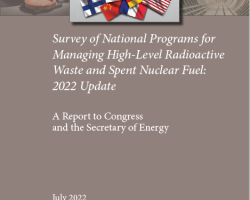Category of Content
Siting Experience Documents Only
Publication Date
Subject Matter
Summary Results for Brine Migration Modeling Performed by LANL, LBNL, and SNL for the UFD Program
Summary Results for Brine Migration Modeling Performed by LANL, LBNL, and SNL for the UFD Program
Modeling Coupled THM Processes and Brine Migration in Salt at High Temperatures
Modeling Coupled THM Processes and Brine Migration in Salt at High Temperatures
Report on Modeling Coupled Processes in the Near Field of a Clay Repository
Report on Modeling Coupled Processes in the Near Field of a Clay Repository
Fluid Flow Modeling in Representative Media
Fluid Flow Modeling in Representative Media
Radionuclide Interaction and Transport in Representative Geologic Media
Radionuclide Interaction and Transport in Representative Geologic Media
Modeling Fluid Flow in Natural Systems: Model Validation and Demonstration
Modeling Fluid Flow in Natural Systems: Model Validation and Demonstration
Brine Migration Experimental Studies for Salt Repositories
Brine Migration Experimental Studies for Salt Repositories
Fluid Flow Model Development for Representative Geologic Media
Fluid Flow Model Development for Representative Geologic Media
Coupled Thermal-Hydrological-Mechanical Processes in Salt
Coupled Thermal-Hydrological-Mechanical Processes in Salt
Status of UFD Campaign International Activities in Disposal Research?
Status of UFD Campaign International Activities in Disposal Research?
Status Report- Modeling of Pit Initiation
Status Report- Modeling of Pit Initiation
Thermal and Deposition Modeling of the Canister Deposition Field Demonstration
Thermal and Deposition Modeling of the Canister Deposition Field Demonstration
Brine Migration Experimental Studies for Salt Repositories
Brine Migration Experimental Studies for Salt Repositories
DESIGNING A CONSENT-BASED SITING PROCESS: SUMMARY OF PUBLIC INPUT REPORT. Final Draft
DESIGNING A CONSENT-BASED SITING PROCESS: SUMMARY OF PUBLIC INPUT REPORT. Final Draft
Guidance for Creating a Community Benefits Plan for Regional Direct Air Capture Hubs
Guidance for Creating a Community Benefits Plan for Regional Direct Air Capture Hubs
This document is intended to provide supplemental information to assist applicants developing a Community Benefits Plan (CBP) for the Regional Direct Air Capture Hubs. As shown in the graphic to the right, Community Benefits Plans are based on a set of four core interdependent policy priorities: engaging communities and labor; investing in America's workforce; advancing diversity, equity, inclusion, and accessibility; and implementing Justice40.
Policies for Achieving Energy Justice in Society: Best Practices for Applying Solar Energy Technologies to Low-Income Housing
Policies for Achieving Energy Justice in Society: Best Practices for Applying Solar Energy Technologies to Low-Income Housing
Studies indicate that the energy burden — energy costs as a percentage of annual family income — on low-income families is inordinately high, compared to that of the rest of the population. Rising fuel costs exacerbate this problem. Residential solar energy systems can help address this situation by furnishing a price-stable energy source with the added benefit of reduced greenhouse gas emissions. However, without appropriate incentives, these systems are prohibitively expensive for low-income families.
Survey of National Programs for Managing High-Level Radioactive Waste and Spent Nuclear Fuel: 2022 Update
Survey of National Programs for Managing High-Level Radioactive Waste and Spent Nuclear Fuel: 2022 Update
In October 2009, the U.S. Nuclear Waste Technical Review Board (Board or NWTRB) published Survey of National Programs for Managing High-Level Radioactive Waste and Spent Nuclear Fuel. For each of the 13 national programs studied, the report catalogued 15 institutional arrangements that had been set in place and 15 technical approaches that had been taken to design repository systems for the long-term management of high-activity radioactive waste.

